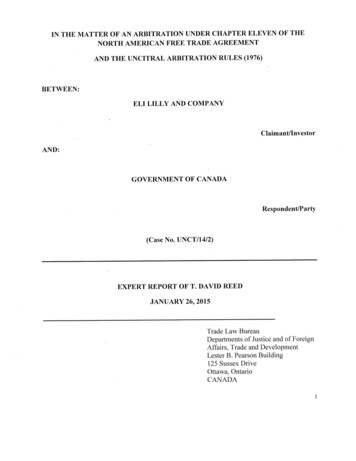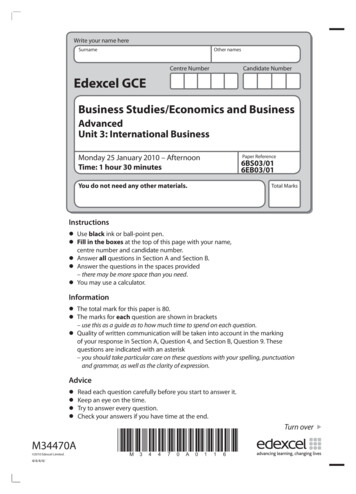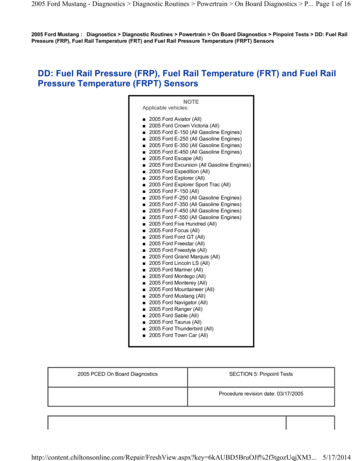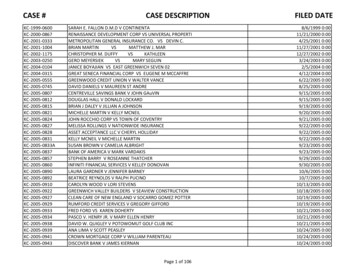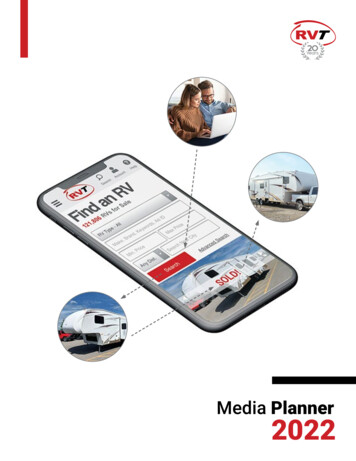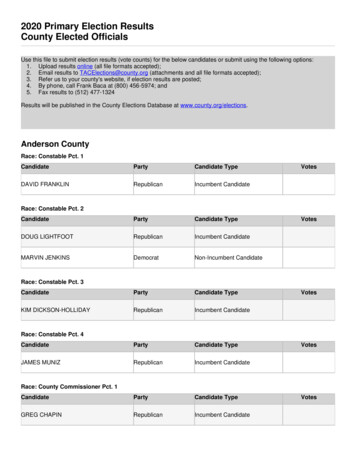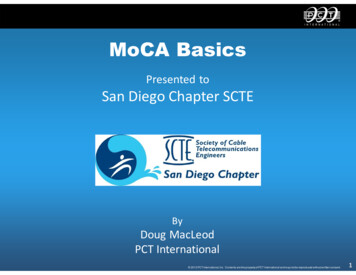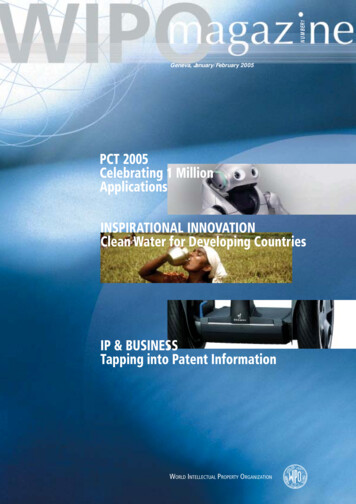
Transcription
Geneva, January/February 2005PCT 2005Celebrating 1 MillionApplicationsINSPIRATIONAL INNOVATIONClean Water for Developing CountriesIP & BUSINESSTapping into Patent InformationWORLD INTELLECTUAL PROPERTY ORGANIZATIONWIPO Magazine//Jan.-Feb. 2005NUMBER 131
WIPO Magazine/Jan.-Feb. 200532World Intellectual Property Day –Think, Imagine, CreateApril 26, 2005, marks the fifth World Intellectual Property Day, whichprovides an opportunity to reflect on how intellectual property (IP)touches all aspects of our lives: How copyright helps bring music toour ears and art, films and literature before our eyes; how industrialdesign helps shape our world, and how trademarks provide reliablesigns of quality; how patenting helps promote ingenious inventionsthat make life easier, faster, safer – and sometimes completely changeour way of living.These things are often taken for granted; there is little public awareness of the connection between human creativity and intellectual property in daily life. Although mostpeople have heard of copyright, patents and trademarks, many view them simply asbusiness or legal concerns, with little effect on their own lives. World IntellectualProperty Day provides an ideal opportunity to improve public understanding of – andrespect for – creativity, innovation, and the intellectual property system by demonstrating their importance in daily life.WIPO will join IP offices, organizations, schools and libraries around the world incelebrating the event with activities on the local, national and regional level.
WIPO Magazine//Jan.-Feb. 20051Table of ContentsAs part of the celebration of the one-millionth application received under the Patent Cooperation Treaty (PCT), this month’s issue of the WIPOMagazine highlights several aspects of the international patent system.Coverage of WIPO’s observance of this landmark event begins on pagetwo, followed by an interview with a research scientist and inventorwhose PCT-registered invention for water purification is being used toaid tsunami relief efforts in Asia. An article exploring the immense value– particularly to enterprises – of the detailed information available inpatent documents begins on page 8. – The Editor2w PCT 2005 - One Million and Counting5w Inspirational Innovators8Photo: FAO/19461/G. BizzarriDr. Ashok Gadgilw IP & BusinessPatent Information: Buried Treasure12 w Establishing IP Institutions in the Least DevelopedCountries (Part IV)16 w Committee MeetingsRevision of International Trademark Law TreatyMember States Tackle Protection of Traditional Knowledgeand FolkloreWork on the Protection of Broadcasting OrganizationsAccelerates20 w New Parties to WIPO-Administered Treaties in 200424 w News Round UpDomain name disputes: from fiction to footballersTrademark protection for Nelson Mandela‘Copyright and Choreography’ Dance PerformanceDisposable DVDs – Countdown to self-destruction26 w Calendar of Meetings27 w New ProductsGeneva,January - February2005
PATENTSWIPO Magazine/Jan.-Feb. 20052PCT 2005ONE MILLION ANDCOUNTING“In my opinion, the PCT is thegreatest advance in foreignpatent practice and patent portfolio management since theParis Convention came intoforce in 1883.” – Mr. T. DavidReed, Senior Patent Advisor, TheProcter and Gamble Company,United States of AmericaWIPO paid tribute to the world’sinnovators at a celebration inGeneva on January 14 to mark onemillion Patent Cooperation Treaty(PCT) applications. Representativesfrom major PCT user companies –Philips Electronics, Nokia, SamsungElectronics, Procter and Gamble,Huawei Technologies andMatsushita Electric – gathered to talkabout why they use WIPO’s international patent filing system, as wellas the challenges faced in its furtherdevelopment.WIPO Deputy Director GeneralFrancis Gurry described thefounders of the PCT as visionaries.“The patent system is the best system that is available to encourageinnovation which leads to improvement in the quality of life,” he said.“Without the patent system, companies would seek to retain their competitive advantage through secrecyand the public domain would be thepoorer.”One million applications speak forthe PCT’s success. Set up to offerinventors a user-friendly, cost-effective and efficient system for filinginternational patent applications,membership has snowballed sincethe PCT began operating in 1978.The system now counts 125 member countries. Expansion has beenaccompanied by regular updating ofPCT Regulations to meet the needsof applicants and patent offices.Creators great and smallFrom the biggest corporations, touniversities, to small businesses andindividuals, the PCT serves innovators from all walks of life. Complexadvances in digital technology, lifesaving discoveries in biotechnology,new products using traditionalknowledge, labor-saving devices,games – all are among the more than10,000 applications now processedby the PCT Office each month. Hereis a sample of the new ideas and newsolutions, which continue to pour infrom across the globe:w Ashok Gadgil’s water disinfectiondevice using ultraviolet (UV) lightis delivering affordable, safedrinking water to rural communities in developing countries. Hefiled the PCT application in 1997.(See our interview with Dr. Gadgilon page 5.)w In Kenya, a partnership betweenuniversity scientists in Nairobiand Oxford, United Kingdom,funded by the International AIDSVaccine Initiative, produced apotential new vaccine againstHIV. Following their PCT application in 2000, the nonprofit partners pledged to use patent ownership in pursuit of their commitment to make a successful vaccine available at minimal cost indeveloping countries.w U.S. inventor Dean Kamen has56 published PCT applications.He is best known for his stairclimbing iBOT wheelchairsand the Segway Human Transporter.w Apple Computer Inc. used thePCT for its iTunes music store,now countering digital piracywith a legal solution for downloading music.Independence iBOT 3000Mobility SystemiTunes music store
WIPO Magazine//Jan.-Feb. 20053“Companies are increasingly being judged on their successin strategically leveraging their intellectual assets – the PCTsystem lays down an excellent path for achieving [this].” –Mrs. Kiran Mazumdar-Shaw, Chairman and Managing Director, BioconGroup, Indiaw Chinese scientists from TsinghuaUniversity filed a PCT applicationfor their process for creating amore environmentally friendly,two-component wet cement.A web gallery of notable PCT Inventions and Inventors is now showingon the PCT website. Visit the gallery at www.wipo.int/pct/en/inventions/.One application 125 countriesA single, international PCT application enables an inventor to seekpatent protection simultaneously inany or all of the 125 ContractingStates. One application form, onelanguage and one set of fees provides the same legal effect as a national application in each State. ThePCT route gives applicants up to 18months longer to decide in whichcountries to pursue national patentprotection: more time for testing andtechnical development of the invention, for researching marketability indifferent countries, and for arranging manufacturing licenses and financing. This also means delayedcosts associated with subsequent national applications. During the international phase, applicants receivehigh-value information from thePCT international search and preliminary report on the likely patentability of the invention in differentcountries. By the time applicantscome to make national applications,they have a wealth of informationon which to base business decisions.Sony’s robot,QrioTop usersw Japanese ground-breaker Sonyused the PCT when developingsophisticated techniques to control the movements of thecompany’s humanoid robots.w One of the first published Egyp-tian applications after Egypt joinedthe PCT in September 2003 wasfiled by Osman Fathi Osman fora honey-based, wound-healingcompound. Some 50 applicationswere filed from Egypt during thefirst year of PCT membership,most by individuals.The US, Japan and Germany are currently the most prolific PCT usercountries, with major multinational companies dominating the top 20list. But use by developing countries is growing fast. The Republic ofKorea is now the seventh overall user worldwide, with China movinginto 13th place.Top 5 overall usersTop 5 developing country usersPhilips Electronics(Netherlands)Siemens (Germany)Matsushita (Japan)Bosch (German)Sony (Japan)LG Electronics (Republic of Korea)Samsung Electronics (Republic of Korea)Council of Scientific and IndustrialResearch (CSIR) (India)Huawei Technologies (China)Ranbaxy Laboratories (India)
WIPO Magazine/Jan.-Feb. 20054“The PCT system brings so many advantages to the applicants,with particular importance to enterprises and individuals ofdeveloping countries.” – Mr. Cheng Xuxin, IP Dept, HuaweiPATENTSTechnologies, Shenzhen, ChinaTowards the futureElectronic filing: faster, cheaper,safer. Now handling over 120,000increasingly complex internationalapplications per year, WIPO is progressively automating PCT procedures for greater efficiency and security. Online, electronic filing wasintroduced in August 2003 and isbeing rolled out to receiving offices.PCT-SAFE (Secure Applications FiledElectronically) cuts costs and savestime for applicants, for WIPO andfor offices.PCT mission. The PCT has found itsplace as an exceptional tool in patenting procedures worldwide. Withapplications already mounting towards the next million, WIPO is vigorously pursuing its PCT mission ofassisting applicants and potentialnew users the world over in the realization of the most precious ofnatural resources, human creativity.PCT Applications from 1985 to 2004PCT applications soared as businesses woke up to the strategic importance of intellectualproperty assets. It took 18 years to reach 250,000 applications but only 4 years to double thatfigure, and another 4 to double again. Global trends indicate a steadier rate of growth for theforthcoming period.The very first PCT applicationto be published was filed onJune 1, 1978 by U.S. residentMrinmay Samanta, for a“method of making glass ofhigh purity and in virtually unlimited shapes.”“Using the PCT system has allowed us to streamline ourinternal processes while maintaining maximum flexibility inobtaining patent protection. One of the most important [futurechallenges for the PCT] will be its ability to maintain the cost/benefit value to applicants while it reduces backlogs andincreases functionality in electronic document exchange.” –Mr. Gary L. Griswold, President and Chief Intellectual Property Counsel,3M Innovative Properties Company, U.S.
5WIPO Magazine//Jan.-Feb. 2005INSPIRATIONAL INNOVATORSDr. Ashok GadgilBorn: 1950,Bombay, IndiaEducation:Bsc Physics,University ofBombay; MScPhysics, Indian Institute of Technology, Kanpur; PhD Physics, University of California, Berkeley.Employment: 1988 to date Lawrence Berkeley National Laboratory (LBNL), California, Environmental Energy Technologies Division; 1983 – 88: Tata Energy Research Institute, New Delhi; 1981:National Centre for Scientific Research, Paris; 1980 – 83: LBLN.Specialist fields: airborne pollutants; energy efficiency in developing countries; drinking water disinfection for developing countries;Patents include: UV Device to Disinfect Drinking Water; PortableEmergency Relief Water TreatmentUnit; Smokeless Ashtray to captureside stream cigarette smoke; Detector for Impending Electronic Failures from Aerosol Deposition; Energy Efficient Device for ExhaustHoods. Patents pending in India:Solar Collector for Rural Applications based on Stabilized Mud;Novel Integrated Solar WaterHeater; Concrete Solar WaterHeater; Energy Efficient Bukhari(space heater).The brains behind the UVW is Indian-born physicist Ashok Gadgil,who began searching for a way topurify water cheaply in developingcountries after an outbreak of “Bengal cholera” in 1993 killed some10,000 people within months. Hehas won numerous awards for theUVW since developing the originaltechnology in 1996, most recentlythe 2004 Health Award from theTech Museum of Innovation1.Ashok Gadgil’s application of simpletechnology to tackle one of the developing world’s most fundamentalproblems is inspirational. WIPOMagazine asked Dr. Gadgil abouthis invention, his experience, as ascientist, of the IP system, and aboutinnovation for development.PATENTSBio-dataWith disease spreading in the wakeof the Asian tsunami, survivors desperately need access to safe drinking water. In some ravaged communities in Sri Lanka and the SouthernIndian state of Tamil Nadu, emergency relief is arriving in the shapeof an innovative water disinfectionunit, the UV Waterworks (UVW).This robust device kills bacteria, viruses and parasites in water from anysource, using nothing more than ultraviolet (UV) light from anunshielded fluorescent lamp powered by a 40-watt power source (forexample a car battery). Treating approximately 15 liters a minute, eachunit can deliver safe drinking waterfor a village of 2,000 for under US 2per person per year, including amortized capital costs.Dr. Gadgil, how did you come bythe idea of inventing a waterdisinfector using UV light?I was looking to see how one caninexpensively disinfect drinkingwater for poor communities in thedeveloping countries. The ability ofUV light to kill bacteria and viruseshas been known for almost a century. I just determined how best touse that ability to design a disinfectorthat is both robust in performance,and efficient in operation.Ingenious simplicity.Using light to cleandrinking water indeveloping countries 1The Tech Museum Awards for technology benefiting humanity, Tech Museum of Innovation, San Jose California: www.techawards.org/ta laureates.cfm
PATENTSWIPO Magazine/Jan.-Feb. 20056You make it sound simple. But others had tried and failed. How wereyou able to find the technical anddesign solutions that eluded them?I greatly enjoy seeking simple solutions to complex questions. For example, simply suspending the lampabove the surface of the water, thenputting an aluminum reflector aboveit to direct back down light thatwould otherwise be lost, solved someof the main problems with previousattempts using an immersed lamp.The engineering design was actuallya product of the constraints and criteria we had to work with. Based onmy experience in India, I knew thatthe unit must not be dependent onpressurizing devices, i.e., it had tobe able to deal with gravity-fed water from sources such as ponds orstreams using buckets. And the treatment had to be quick, so it neededa fairly high flow rate. Simplicity wasa very important goal in my mindall along the design process.I wanted no moving parts, a simpledesign that should remain easy tofabricate, with cheap and easy maintenance for the poorest communities. It was a joyful moment when itworked so well in our tests.What particular difficulties did youface?Getting funding was quite difficult.Fortunately I received some fundingfrom a couple of project managersin the government, as well as seedfunding from a couple of privatefoundations. This paid for direct expenses. Funding for salaries was2much harder to come by. Mostly Iworked on my own time, and usedthe funds to support students and forhardware.How did your invention get fromlaboratory to production?University of California/LawrenceBerkeley National Lab (UC/LBNL),my employer, owns the rights to thepatent – I assigned it to them perconditions of my employment.WaterHealth International (WHI)2was among a dozen or so companies that approached UC/LBNL,each company asking for an exclusive license. After due process, UC/LBNL’s Technology Transfer officeselected WHI as the licensee ofchoice.How is the UVW currently beingused?There are more than 300 installations of UVW systems around theworld already, primarily in Mexico,the Philippines and now in India, aswell as handfuls in a dozen othercountries. (For details see www.waterhealth.com). The systems developed by WHI are modular so canbe used in different ways, for example, as community water systemsin remote villages; as water refillingstores, owned and operated by local entrepreneurs in urban centers;or as household systems, which canalso provide water for hospitals orschools. WHI is also making available, on a cost-recovery basis, UVWsystems for tsunami relief. The emergency relief units costs US 10,000and include UVW, tanks and pumps,multiple filters, electronic level indicators and electrical controls,shipping, installation, commissioning, training of local community, andparts and maintenance for five years.Several dozens of these systems willbe placed in camps of tsunami sur-WaterHealth International, Inc. California, an innovation-driven company, set up to develop technologies and business models to providehigh quality, affordable water worldwide. www.waterhealth.com
WIPO Magazine//Jan.-Feb. 20057vivors in the next weeks and months,and will be moved to their villagesas they rebuild their lives.When did you start considering patenting your idea? And how did youdecide to file an international application via the Patent CooperationTreaty (PCT)?I initially considered just putting upmy design on the Internet for all tofreely copy. LBNL’s TechnologyTransfer Department (licensing andpatent officers) persuaded me of theClean water: a globalchallenge3w Over 1.1 billion people lackwwwww3access to clean water.There are 1.8 million deathsper year from diarrhoeal diseases alone.90 percent (approx. 200 perhour) are children under agefive.88 percent are caused byunsafe water and sanitation.Millions more die or sufferfrom other water-related diseases.“We shall not finally defeat[any of the] infectious diseases that plague the developing world until we havealso won the battle for safedrinking water, sanitationand basic health care.” KofiAnnan, United Nations Secretary-General.advantages of patenting. Patentingwould protect against badly manufactured copies with corner-cuttingfabrication that would not then function as well as the genuine article.To tell you the truth, I was not awareof the PCT filing approach. It wasLBNL’s patent attorneys who educated me about the advantages ofthe PCT route when they identifiedthat the primary application of theinvention would be abroad. Thiswas an enormous help to WHI,when they licensed the inventionfrom LBNL.How did you find the process of licensing/negotiating over IP rights?It has been a learning experience forme. This is something that no oneteaches us scientists during our formal education. I am grateful thatLBNL has fine licensing and patentofficers.Can you offer any thoughts on howto encourage innovation to benefitdeveloping countries?There is enormous talent and creativity at the grassroots where peopleare inventing new ways to tackletheir daily problems. A multipronged approach to encourage,recognize, protect and commercialize many of these inventions willgreatly help in improving the livelihoods of ordinary people in the developing countries. I am pleased andhonored to be part of the effort bythe Lemelson Foundation (Initiativeon Invention and Innovation for Sus-tainable Development) to encouragesuch efforts in many parts of the developing world.What advice can you offer to younginnovators in developing countries?Dare to dream, and aim high. At thesame time, keep your feet on theground regarding protection of yourintellectual property and turning itinto a good business.Your hopes for the future?I hope we find ways to unleash andnurture the creative genius of hundreds of thousands of individualsaround the world who have goodideas but don’t know what to dowith them, or are not able to turnthem into products that benefit humanity For more information see the LawrenceBerkeley National Laboratory websiteon www.lbl.govWorld Health Organization Facts on Water Sanitation and Health www.who.int/water sanitation health/facts2004/en/
PATENTSPATENT INFORMATION:BURIED TREASUREPlanning a merger or acquisition?Looking for creative minds to leadthe way in research and development (R&D)? Need to identify thestate-of-the-art in a technologicalarea to launch a new product? Lookno further. Patent information, thelargest repository of technical information in the world, has the answerto these and more.Patent information is the sum totalof all the information contained inevery patent document ever published. To date this means some 42million patent documents worldwide in every technical field, withabout one million more documentsadded each year. As well as patentsfor inventions, it includes inventors’certificates, utility certificates andutility models. A veritable treasuretrove, patent information is the largest, most up-to-date and well-classified collection of technical documentation on new technologies.Outside the patent office, patent information was once largely the preserve of patent agents or attorneys,skilled in conducting searches as thefirst step in filing patent applicationsor preparing for patent litigation. Butin the last decade, the developmentof computerized databases of patentinformation, many of them onlineand free-of-charge, has opened thedoors to users across the board. Businessmen, economists, researchersand policymakers the world over arewaking up to the potential value ofpatent information.Patent information has become astrategic business tool. It is beingused to forecast the direction of technical change, or to assess acompany’s relative technologicalstrength in a marketplace. Analyzingtrends revealed by patent information helps to identify potentiallyprofitable areas for R&D, key technologies and market opportunities.Studying technical information mayhelp to predict the success or failure of a new product under development and, consequently, the success or failure of the company itself.What is in a patentdocument?The patent system is based on a twoway deal. In exchange for an exclusive, time-limited, legal right to prevent others from making, using, offering for sale, selling or importinga patented invention without thepatent owner’s permission, theowner is legally required to disclosethe invention to the public. Disclosure serves the wider public good,by enabling others to understand thenew solutions or technology underpinning each invention, thus in turnfuelling further technological advances. Each patent applicant, therefore, is obliged to provide a detaileddescription of the claimed inventionin the application.Patent applications are similarlystructured worldwide. They consistof a front page, a specification,claims, drawings (if necessary) andan abstract. A patent applicationIP ANDBUSINESSWIPO Magazine/Jan.-Feb. 20058may be anything from a few pagesto hundreds of pages long, depending on the nature of the specific invention and the technical field.The front page of a published patentdocument generally displays bibliographic information, such as the titleof the invention, the date of filing,the priority date, the relevant technical field, the name and address ofapplicant(s) and inventor(s). It alsocontains an abstract, which gives abrief summary of the invention, anda representative drawing. The bibliographic information is an essential means of identifying, locatingand retrieving patent documents.The patent specification must describe the claimed invention and thetechnical information contained init in enough detail that anyoneskilled in the same technical fieldcould reconstruct and practice theinvention without putting in furtherinventive effort. Most countries require that the specification includethe title of the invention, the background to the invention, a summary,a brief description of drawings (ifnecessary) and a detailed description of the invention.The claims determine the patentability and scope of the claimed invention. In patent litigation, interpreting claims is the first step in determining whether the patent is validand whether the patent has beeninfringed.
WIPO Magazine//Jan.-Feb. 20059In most countries a patent application is published 18 months after itis filed, so there is a time lag between the publication of the patentapplication and the time of invention. Generally, however, patents aregranted well before a patented product is introduced on the market. Sothe publication of a patent application is the earliest moment when therelevant information becomes available to the public. Moreover, thepatent document provides muchmore detailed information about atechnology than any other type ofscientific or technical publication.And it is estimated that more than70 percent of the information disclosed in patents is never publishedanywhere else.1Patents do not, of course, cover every kind of inventive activity in every country. Some patentable inventions are either kept as trade secretsor put into the public domainthrough defensive publication in order to prevent anyone else from obtaining a patent on that invention.Both are valid business strategies.Nor do they diminish the importance of patent documents as a business resource.Input to licensing strategy. Licensing technology – into or out of acompany – requires reliable information in order to make the rightbusiness decisions. If the technologyin question is valuable enough, itwill generally be protected by apatent because of the intrinsic difficulty of protecting it as a trade secret. Analyzing patent informationwill provide pertinent technical andbusiness information about the technology. Before starting licensing negotiations, it is essential to have agood understanding of the targettechnology itself, and of its values,in terms of its strengths and weaknesses. Patent analysis will also reveal the availability of competingtechnology in the same field.While preparing to license-in technology, a company should analyzepatent information to determinewhether:w the technology in question is pro-tected, or is already in the publicdomain in the target market dueto its non-protection, expiration,non-payment of maintenancefees or invalidation of the patentin a court proceeding;w the owner of an existing or competing patent could bring an action for infringement;w the technology is overvalued orundervalued in comparison withother related or alternative technologies.Publication dateCredit: Segway LLCA unique sourceFirst filing dateApplicantInventorSegway HumanTransporter (HT) i170in midnight blueTitleAbstractDrawingExample of the front pageof a PCT patent applicationfor an invention by Mr. DeanKamen, subsequentlycommercialized as theSegway HumanTransporterBusiness uses of patentinformationMany areas of business can benefitfrom patent information analysis.Some of the practical applicationsinclude: 1“Global Patent Sources - An overview of International Patents”, Derwent Information, 1999/5.
WIPO Magazine/Jan.-Feb. 200510Similarly, while preparing to licenseout technology, analysis of patentinformation will help a company todetermine:PATENTSw who could be prospective li-censees in the marketplace;w how much potential licenseesmight be willing to pay for thetechnology;w whether it is a core technologyin the business, such that licensing it out might become an obstacle to its further developmentand use.Cross-licensing, an agreement between two companies to license oneor more patents to each other, mayinvolve payments if one of the parties is perceived to have a patentportfolio of lesser value than theother. Patent analysis plays a role incomparing the patent portfolios ofthe two companies in order to decide who should pay whom andhow much.Supporting mergers and acquisitions. If a company wishes to acquire a specific technology alongwith other complimentary assetsthrough a merger or acquisition,then it should first identify all thecompanies with relevant patents. Aninitial patent search can identifythese. Further patent analysis willhelp to narrow down the choicesand to decide which company is thebest target. Once a target companyis identified, patent analysis can alsoaddress additional questions suchas: Is the target’s technology as good2as claimed? Is the company pricedfairly? Who are the innovators andwill they stay with the merged oracquired company? For example, alarge company may acquire a smallspecialty business as part of a broadstrategic plan to fill gaps in its technology base. However, upon completing the acquisition, the companymay discover that the R&D capabilities of the small company are reduced, because they were dependent on one key researcher, who didnot come along as part of the dealhaving been transferred to the parent company before the sale wascompleted. If the large companyhad done its patent analysis thoroughly prior to the acquisition, theycould have identified the researcherin advance and taken appropriatesteps to retain him.thus save huge amounts in litigationfees and payments of compensationfor damages.Guiding R&D. Before developing anew product or going into a newbusiness, a company should seek anoverview of the relevant technologyfield in order to forecast marketneeds. Patent information analysismakes it possible to map out thetrend of technological change andthe life cycle of a technology –growth, development, maturity anddecline. It will also identify the competitors’ technological assets, as wellas the problems and solutions in thedevelopment of a particular technology. Knowing the life cycle of atechnology makes it possible tojudge the right time to invest in thedifferent aspects of relevant researchand development. Patent analysiscan also prevent infringement, andHuman resources. Research2 hasshown that a small number of prolific inventors drive technologicaldevelopment, whereas most researchers produce only one or twopatented innovations. Patent analysis, such as co-inventor brain maps,can reveal the key inventors who arevitally important for the future of thecompany. Such brain maps can identify star inventors within a companyand in other companies, providing avaluable tool for retaining or headhunting talented individual
Paris Convention came into force in 1883." - Mr. T. David Reed, Senior Patent Advisor, The Procter and Gamble Company, United States of America WIPO paid tribute to the world's innovators at a celebration in Geneva on January 14 to mark one million Patent Cooperation Treaty (PCT) applications. Representatives from major PCT user companies -

